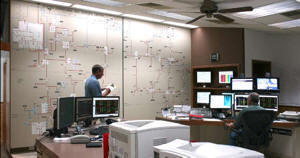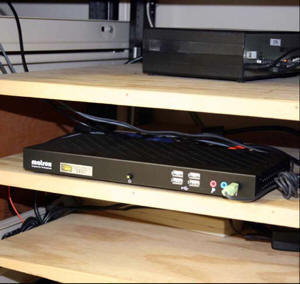November 2009
![]()
AutomatedBuildings.com
[an error occurred while processing this directive]
(Click Message to Learn More)
November 2009 |
[an error occurred while processing this directive] |
|
|
Camille
Caron |
About Northwest Iowa Power Cooperative
|
|
|
|
|
|
|
|
|
|
|
|
|
[an error occurred while processing this directive] |
|
|
|
|
|
|
|
|
|
|
|
|
|
|
|
[an error occurred while processing this directive] |
 Northwest
Iowa Power Cooperative (NIPCO) is a generation and transmission rural electric
cooperative supplying power to seven Class A members and 13 Class B members in
western Iowa. To control the 850 miles of transmission line in its service
territory, NIPCO uses a Supervisory Control and Data Acquisition system (SCADA)
manufactured by Open Systems International (OSI), located in Minneapolis,
Minnesota.
Northwest
Iowa Power Cooperative (NIPCO) is a generation and transmission rural electric
cooperative supplying power to seven Class A members and 13 Class B members in
western Iowa. To control the 850 miles of transmission line in its service
territory, NIPCO uses a Supervisory Control and Data Acquisition system (SCADA)
manufactured by Open Systems International (OSI), located in Minneapolis,
Minnesota.
The
control system is comprised of five networked servers and five
workstations providing a graphical interface using dual - or in some cases -
quad displays. Through a man-machine interface, the SCADA system controls the
NIPCO power grid. The servers and workstations are located away from the power
dispatching area where the control and monitoring of the power grid actually
takes place. The reason for this arrangement is to keep the key components of
the SCADA system in a dry, cool, and clean environment.
The Challenge
In the past, standard Keyboard, Video, and Mouse (KVM)
extenders provided the link between the workstations in controlled environmental
chambers and the dispatching work area. This worked to distance the components,
but the KVM extenders were subject to induced magnetic fields and interference
regularly. It usually found its way into the shielded and unshielded Category 5
(Cat-5) cables between the KVM extender end units. The source for the
interference was found to be from flickering florescent lights; motors starting
and stopping; radio frequency interference; lighting dimmer switches; and last
but not least, differences in ground rise potential between the two rooms. In
such a controlled environment, even small moves of any of the cables under the
computer floor could cause the KVM switch to lock up or system instability to
occur. If that happened, the KVM switch needed to be reset, or the Cat-5 cable
needed to be moved to a different location to minimize the induced electrical
noise or interference.
Another issue NIPCO needed to address was the shift in the IT industry away from
legacy PS-2 computer interfaces for the mouse and keyboard, in favor of the
Universal Serial Bus interface (USB). It was very clear NIPCO needed to replace
their legacy setup for remotely interfacing to the workstations' CPUs.


The Solution
In an effort to find a solution to replace this
outdated technology and eliminate their interference problems, NIPCO visited
DistribuTech, an industry trade show specializing in showcasing the newest
technologies for automation and control systems. It was at the Matrox Graphics
booth that they found their solution: the
Matrox Extio F1400 remote graphics unit (RGU). Extio leverages
PCI Express bus extension technology to separate the I/O devices from the
computer and drives multiple displays from the monitoring location. With Extio's
support for multimode fiber-optic cable, the NIPCO control system would be
impervious to the challenges of the "wired" system.
[an error occurred while processing this directive]
The Result
Once installed and powered up, the Extio F1400 unit
worked immediately. The quality of graphics improved considerably on the video
displays. Even the projection map board showed marked improvement in resolution
and sharpness.
NIPCO’s control operators record and chart system power flows on multiple
monitors, and one Extio unit per operator system supplied video to all four
monitors with superb resolution. An additional benefit of Extio over traditional
KVM extension technology was there were now USB ports to support workstation
devices, and PC audio at the operator location. The unique part of this
solution—it is all over a single non-conductive, multimode fiber-optic cable
instead of four or more separate video and workstation cables running from the
environmental controlled room to the dispatching center.
With the great success of the Extio rollout in the SCADA system, the cooperative
has now decided to incorporate Extio F1400 into their energy management system
as well. The energy management system controls appliances such as electric water
heaters, air conditioners, and irrigation systems with radio signals which are
broadcast to receivers installed on homes and farms in rural western Iowa. This
energy management system is leveraged several times monthly when the demand for
electricity energy is at its highest. Through this technology, NIPCO is able to
defer that load for several hours, reducing the cost of electricity to the end
consumer.
"Without the Matrox Extio remote graphics technology, NIPCO would be confronted
with many challenges of operating a number of PC workstations away from the
actual area where they are needed," stated Dennis Hill, VP Telecommunications
Services, Northwest Iowa Power Cooperative. "Extio is a unique, superior product
that has fully filled the needs of Northwest Iowa Power Cooperative."
For More Information: The Matrox Extio Series is
ideal for environments requiring data security, low heat emissions, no noise,
and more workspace. For more information, visit Matrox Graphics at
http://www.matrox.com/graphics or
contact us directly at graphics@matrox.com.
[an error occurred while processing this directive]
[Click Banner To Learn More]
[Home Page] [The Automator] [About] [Subscribe ] [Contact Us]